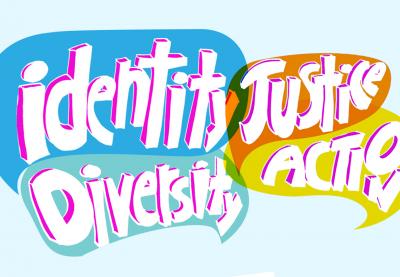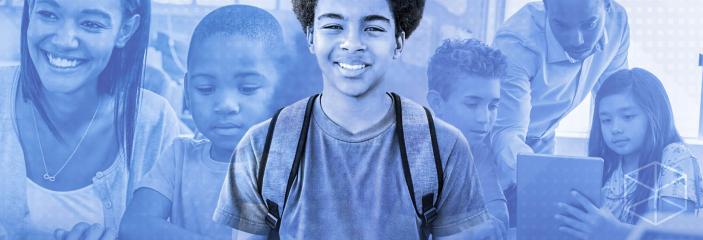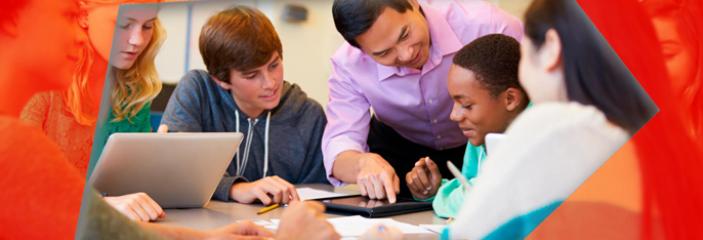Amy Bintliff knew the students in her seventh-grade class regularly witnessed bullying at school—and that they hesitated to say anything about it.
“Immobility is one of the problems in our building,” Bintliff says. “Kids can see it and hear it, but they don’t act and respond.”
Her administration was tackling the bystander mentality through school climate-improvement efforts, but Bintliff wanted to take bullying on in the classroom. She knew that she, like many other anti-bias educators, needed a teaching tool that would help her set performance goals and measure student progress related to issues of inclusion, bias and social justice.
Then she learned of the Social Justice Standards: The Teaching Tolerance Anti-bias Framework.
The Social Justice Standards are a set of anchor standards and learning outcomes, ideal for teachers like Bintliff who embrace both social justice values and backward planning. Divided into four domains—identity, diversity, justice and action—the Social Justice Standards provide a common language and organizational structure teachers can use to guide curriculum development for students and to communicate with professional learning communities about social justice teaching goals and practices.
Bintliff initially focused on three action standards and one diversity standard, a decision she hoped would empower her students to change the school’s bystander culture. She and her students began their exploration by learning the vocabulary of the learning outcomes.
“We wrote down our ideas of the standards and defined words like exclusion. And then students throughout the week would bring in examples of exclusion they saw,” she explains. “Each student would share ideas about what they were seeing around the building or in their own life. And then we set goals.”
The outcomes of the Social Justice Standards are broken out by grade level. Bintliff says this format allowed her 12-year-old students to write goals related to such mind-bending concepts as action and justice. Writer and educator Julie Olsen Edwards worked with Teaching Tolerance to create age-appropriate outcomes for each anchor standard. She points out that the Social Justice Standards are unique in that they offer children the opportunity to encounter the anchor standards every year throughout their K–12 education.
“[I] was trying to write them in a way that made it more obvious that these issues keep coming up over and over and over again; we just address them in more sophisticated ways,” Edwards says. “One of the essential, bedrock skills and understandings children can have is how to live in a world that is as pluralistic, diverse, multicultural and inequitable as our world is. And that has to be an underpinning for every kid if they’re going to survive and thrive. … [The Social Justice Standards] fit in every single arena of our learning. They underpin everything.”
Bintliff agrees. In addition to using the Social Justice Standards to address school-climate issues, she used them as a tool to teach critical literacy and creative writing. Her students reflected on the standards while reading Ninth Ward. They wrote poems about times they felt excluded. They even helped Bintliff develop standards-based lesson plans for their advisory periods.
“[It gives] kids the understanding that, ‘Wow, this related to all of our work!’ Now the students are asking, ‘What standard does this relate to?’” Bintliff says. “They understand injustice and they understand a lot of the concepts, but we don’t always give them the opportunity to show growth in those areas … By giving them the chance to do that I am learning so much about what it’s like to be a middle school student because they are able to openly say what’s happening and how they’ve been victims of a culture that they want to change.”
A year of using the Social Justice Standards, says Bintliff, has done more than change her students’ ability to stand up and take action within their school. It has pushed her to explore anti-bias and social justice values more deeply than she ever had.
“I’m creating [a] better curriculum because of [the Social Justice Standards],” she says. “It’s making me a better teacher.”
Explore Further
Want to read more about the ideas that sparked the Social Justice Standards? Check out Louise Derman-Sparks’ Anti-Bias Curriculum: Tools for Empowering Young Children and the expanded sequel, Anti-Bias Education for Young Children and Ourselves (co-authored with Julie Olsen Edwards).
Building on a Strong Foundation
Veteran teacher Emily Chiariello is the teaching and learning specialist who led the development of the Social Justice Standards. Chiariello combed through decades of social justice literature, looking for raw material from which Teaching Tolerance could develop standards appropriate for backward planning for social emotional learning. Her research led her to the work of Louise Derman-Sparks and Anti-bias Curriculum: Tools for Empowering Young Children. In this groundbreaking 1989 book, Derman-Sparks identified what she called “the primary goals of anti-bias education in early childhood.” To meet these goals, each child must:
1. demonstrate self-awareness, confidence, family pride, and positive social identities;
2. express comfort and joy with human diversity; accurate language for human differences; and deep, caring human connections;
3. increasingly recognize unfairness, have language to describe unfairness, and understand that unfairness hurts;
4. demonstrate empowerment and the skills to act, with others or alone, against prejudice and/or discriminatory actions.
“[The four goals] gave us a powerful starting place,” Chiariello says. “They really engaged a range of social justice issues.”
This range made the goals unique among many social justice teaching materials, which tend to focus on one of two areas: either reducing prejudice or advocating collective action to change inequitable structures. Prejudice reduction seeks to minimize conflict and generally focuses on changing attitudes and behaviors. A collective action approach, however, utilizes conflict to raise consciousness and catalyze action.
In the 25 years since Derman-Sparks published her anti-bias education goals, other disciplines have developed standards and benchmarks. But these tools have been missing in anti-bias education. Chiariello and her team filled that gap by distilling Derman-Sparks’ goals into 20 anchor standards in four domains for anti-bias teaching and learning: identity, diversity, justice and action. “The domains are completely interconnected, yet distinct,” Chiariello notes. “Each is necessary, but none alone is sufficient.”
Derman-Sparks has been a supporter of the Social Justice Standards from the beginning. She asserts that if teachers take a developmental approach and make skillful use of the grade-level outcomes, the range of teaching opportunities supported by the Standards can offer many emotional, social emotional and cognitive benefits for children.
“You’re creating an environment where real democracy and real equality is being practiced,” Derman-Sparks says. “It means that children are learning how to understand who we are and understand different perspectives and learn how to deal with different situations that come up that are not fair. … Cognitively it means that children will do better learning. … When kids are experiencing a school … where who they are is visible and respected and kids are talking about fairness and justice and practicing it, then learning is enhanced for everybody.”
K-12 Continuity
The Social Justice Standards help teachers explain complex concepts—such as identity, diversity, justice and action—whether talking with children in kindergarten or young adults about to graduate. Here’s an example:
IDENTITY ANCHOR STANDARD 4 (ID.4)
Students will express pride, confidence and healthy self-esteem without denying the value and dignity of other people.
At the K-2 level, the learning outcome looks like this:
I can feel good about myself without being mean or making other people feel bad.
At the 3-5 level, students can understand:
I can feel good about my identity without making someone else feel badly about who they are.
The middle school outcome expands on this concept:
I feel good about my many identities and know they don’t make me better than people with other identities.
By senior year, students can understand:
I express pride and confidence in my identity without perceiving or treating anyone else as inferior.
Click here to see the full set of grade-level outcomes!


